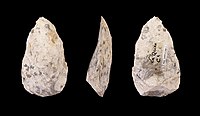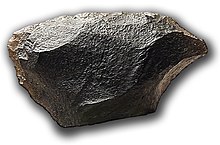Racloir: Difference between revisions
Appearance
Content deleted Content added
Importing Wikidata short description: "Type of flint tool" (Shortdesc helper) |
No edit summary |
||
| Line 1: | Line 1: | ||
{{Short description|Type of flint tool}} |
{{Short description|Type of flint tool}} |
||
[[File:RacloirLa Quina MHNT PRE.2009.0.206.1 (2).jpg|right|thumb|200px|Type of [[Mousterian]] Racloir]] |
[[File:RacloirLa Quina MHNT PRE.2009.0.206.1 (2).jpg|right|thumb|200px|Type of [[Mousterian]] Racloir]] |
||
In archaeology, a '''racloir''', also known as ''racloirs sur talon'' (French for scraper on |
In archaeology, a '''racloir''', also known as ''racloirs sur talon'' (French for scraper on heel), is a certain type of [[flint]] tool made by prehistoric peoples. |
||
[[File:Raedera Atapuerca (TG11).jpg|left|thumb|'''Racloir''' from Galería (TG11) of [[Archaeological Site of Atapuerca|Atapuerca]]]] |
[[File:Raedera Atapuerca (TG11).jpg|left|thumb|'''Racloir''' from Galería (TG11) of [[Archaeological Site of Atapuerca|Atapuerca]]]] |
||
It is a type of side scraper distinctive of [[Mousterian]] assemblages. It is created from a flint [[lithic flake|flake]] and looks like a large [[Scraper (archaeology)|scraper]]. As well as being used for scraping hides and bark, it may also have been used as a knife. Racloirs are most associated with the [[Neanderthal]] [[Mousterian]] [[archaeological industry|industry]]. These racloirs are retouched along the ridge between the striking platform and the dorsal face. They have shaped edges and are modified by abrupt flaking from the dorsal face. |
It is a type of side scraper distinctive of [[Mousterian]] assemblages. It is created from a flint [[lithic flake|flake]] and looks like a large [[Scraper (archaeology)|scraper]]. As well as being used for scraping hides and bark, it may also have been used as a knife. Racloirs are most associated with the [[Neanderthal]] [[Mousterian]] [[archaeological industry|industry]]. These racloirs are retouched along the ridge between the striking platform and the dorsal face. They have shaped edges and are modified by abrupt flaking from the dorsal face. |
||
Latest revision as of 18:45, 20 April 2023

In archaeology, a racloir, also known as racloirs sur talon (French for scraper on heel), is a certain type of flint tool made by prehistoric peoples.

It is a type of side scraper distinctive of Mousterian assemblages. It is created from a flint flake and looks like a large scraper. As well as being used for scraping hides and bark, it may also have been used as a knife. Racloirs are most associated with the Neanderthal Mousterian industry. These racloirs are retouched along the ridge between the striking platform and the dorsal face. They have shaped edges and are modified by abrupt flaking from the dorsal face.
References
[edit]- Lewin, Roger (2005). Human Evolution: An Illustrated Introduction. Wiley-Blackwell. p. 225.
- Barkai & Gopher, R (1998). "Reintroducing Butt Scrapers (Racloirs Sur Talon): Another Look at a Non-formal Tool Type". Lithic Technology. p. 22.
- Racloir. The Concise Oxford Dictionary of Archaeology. 2008.
